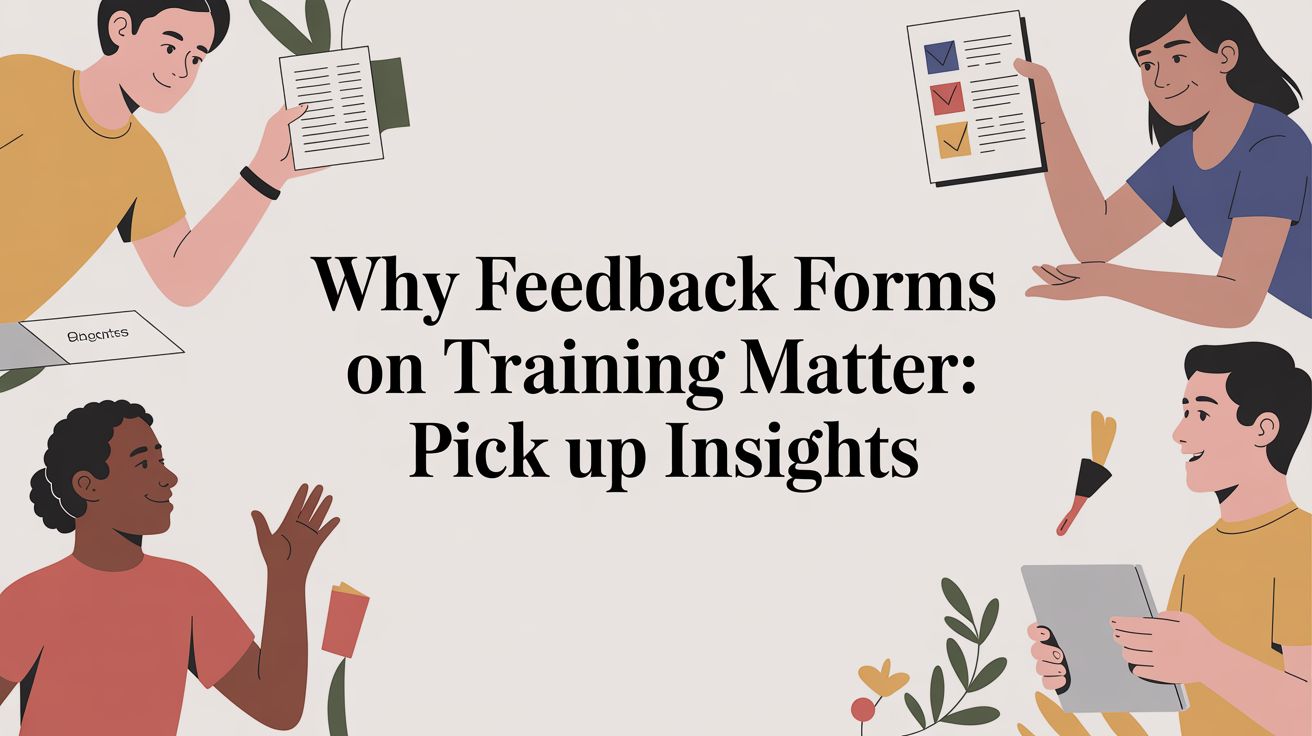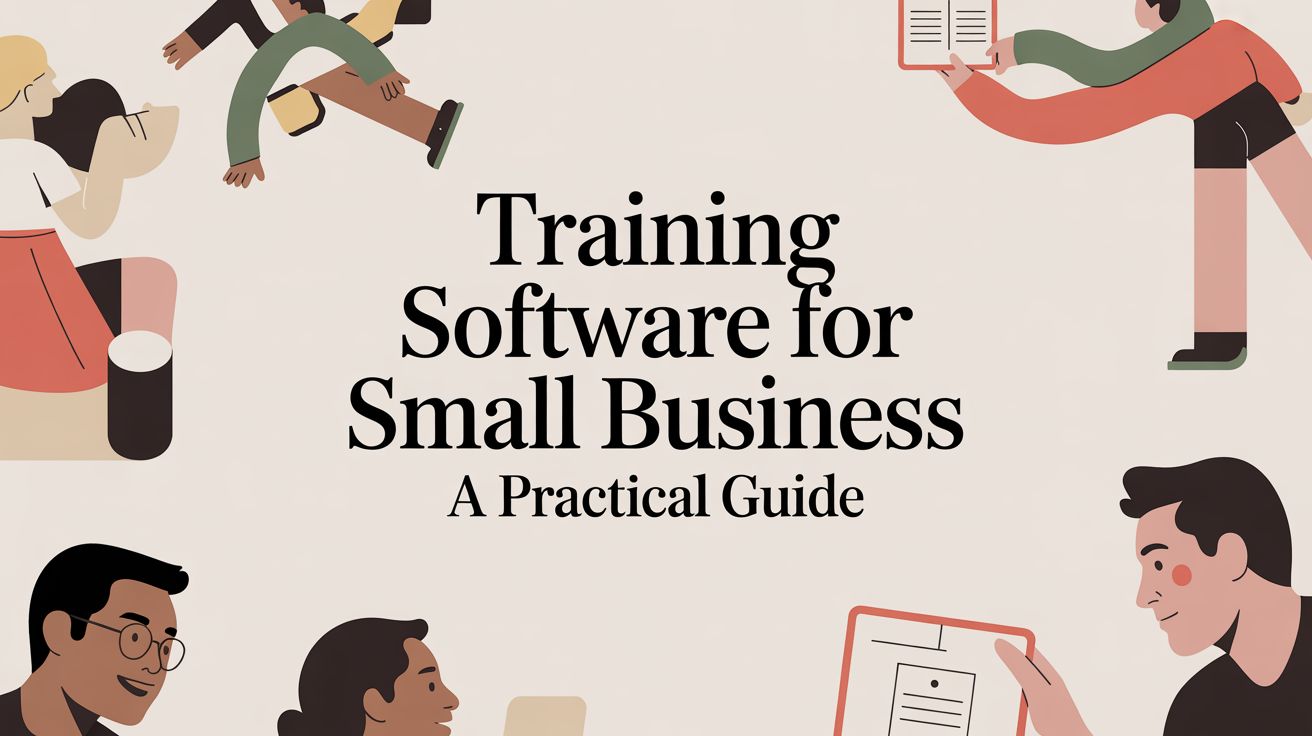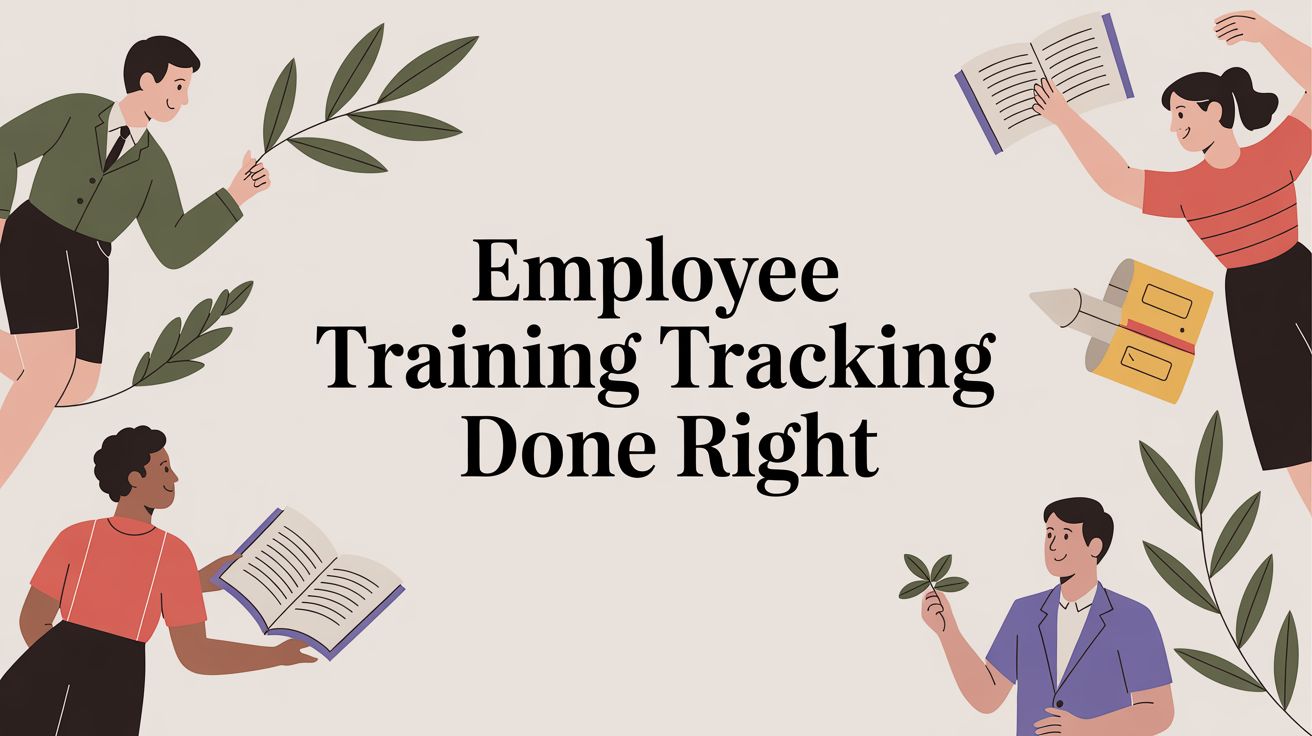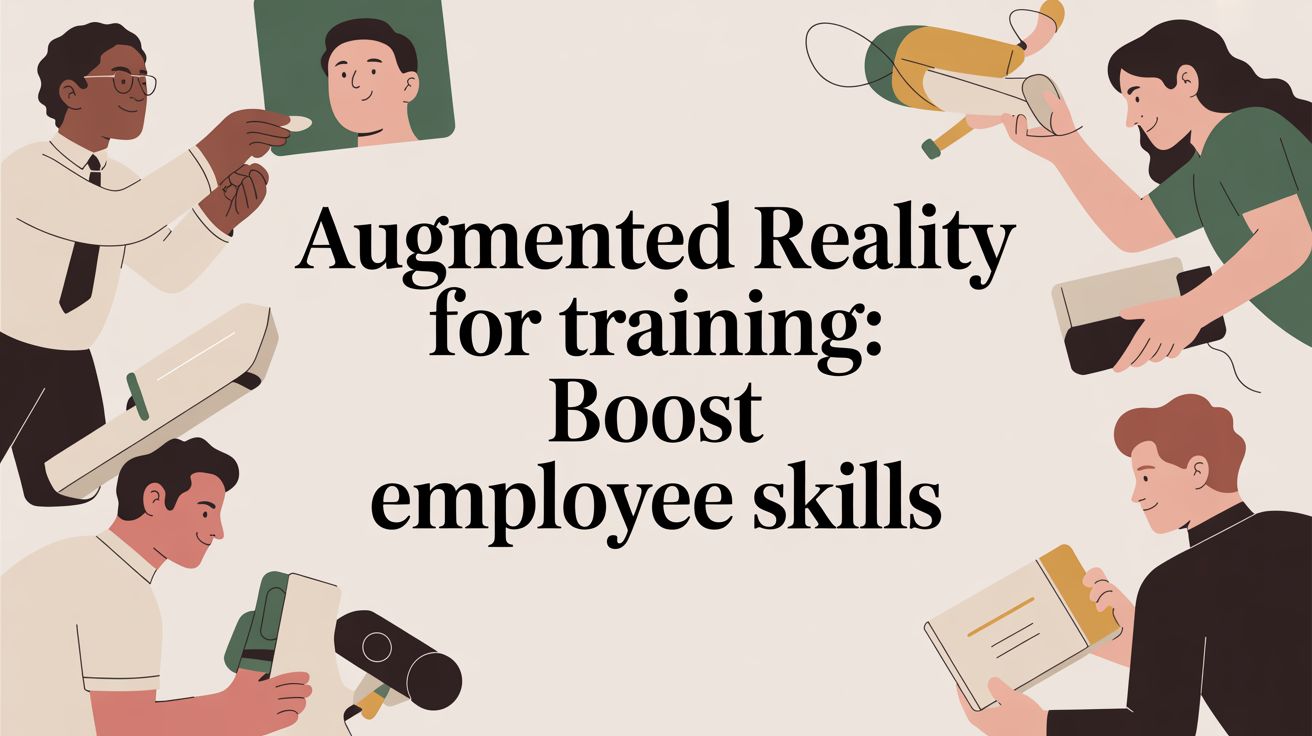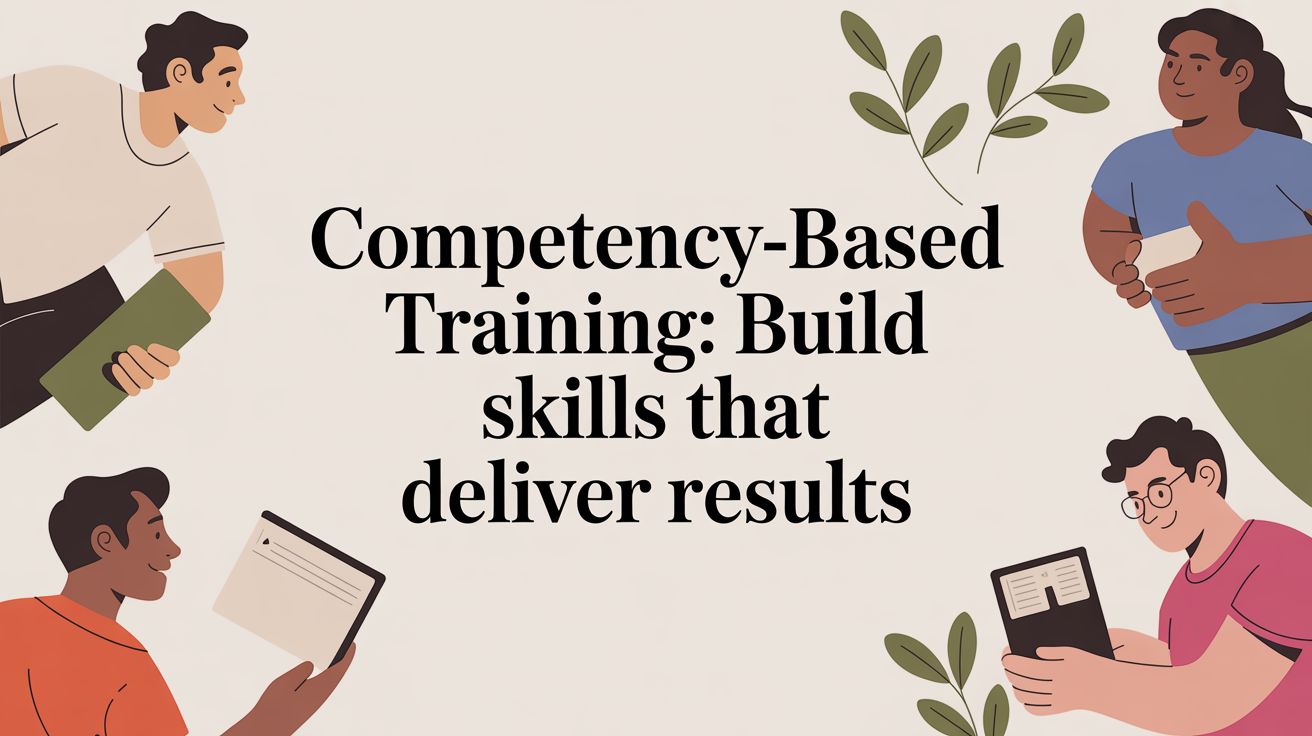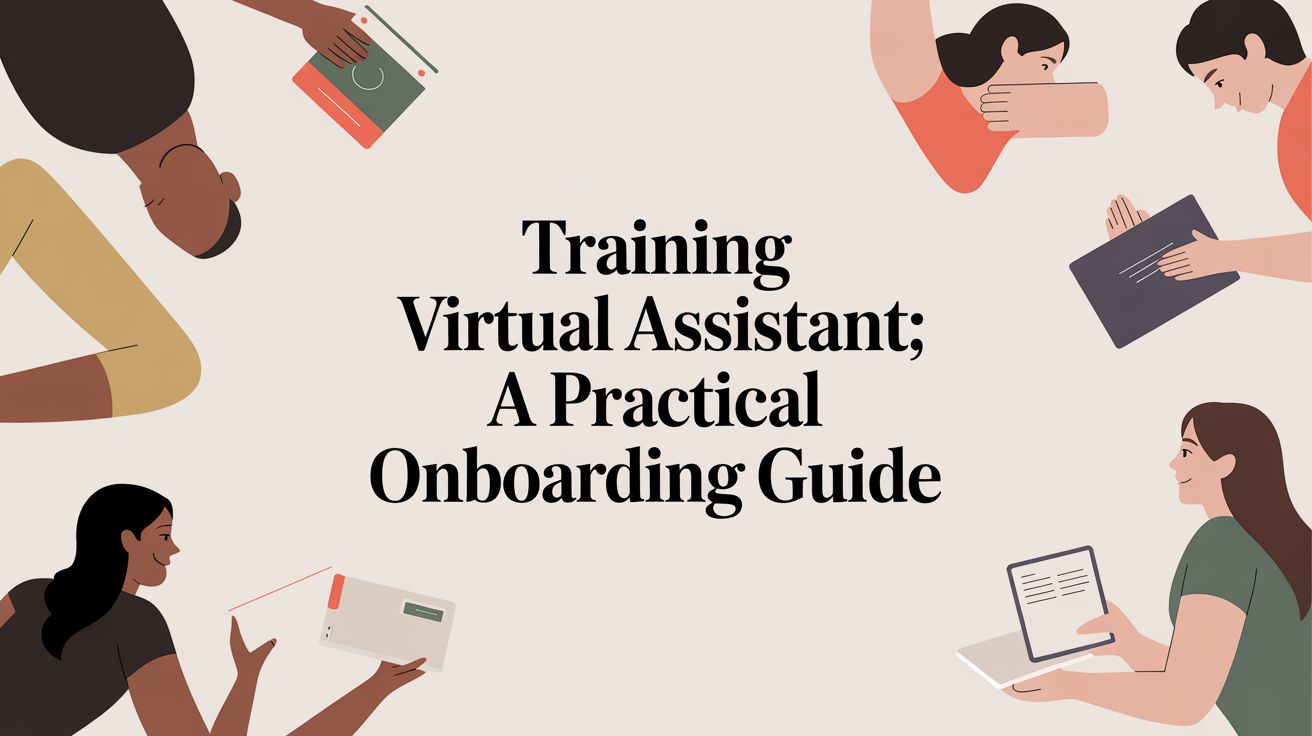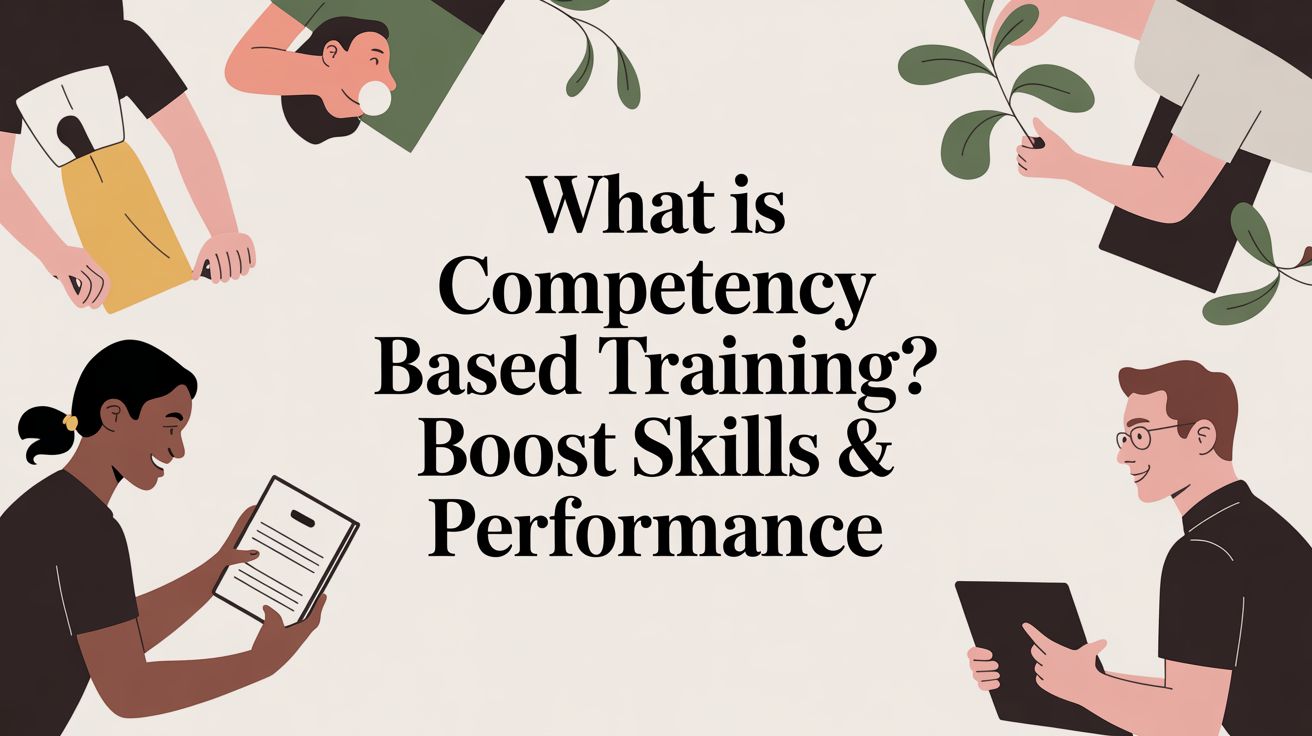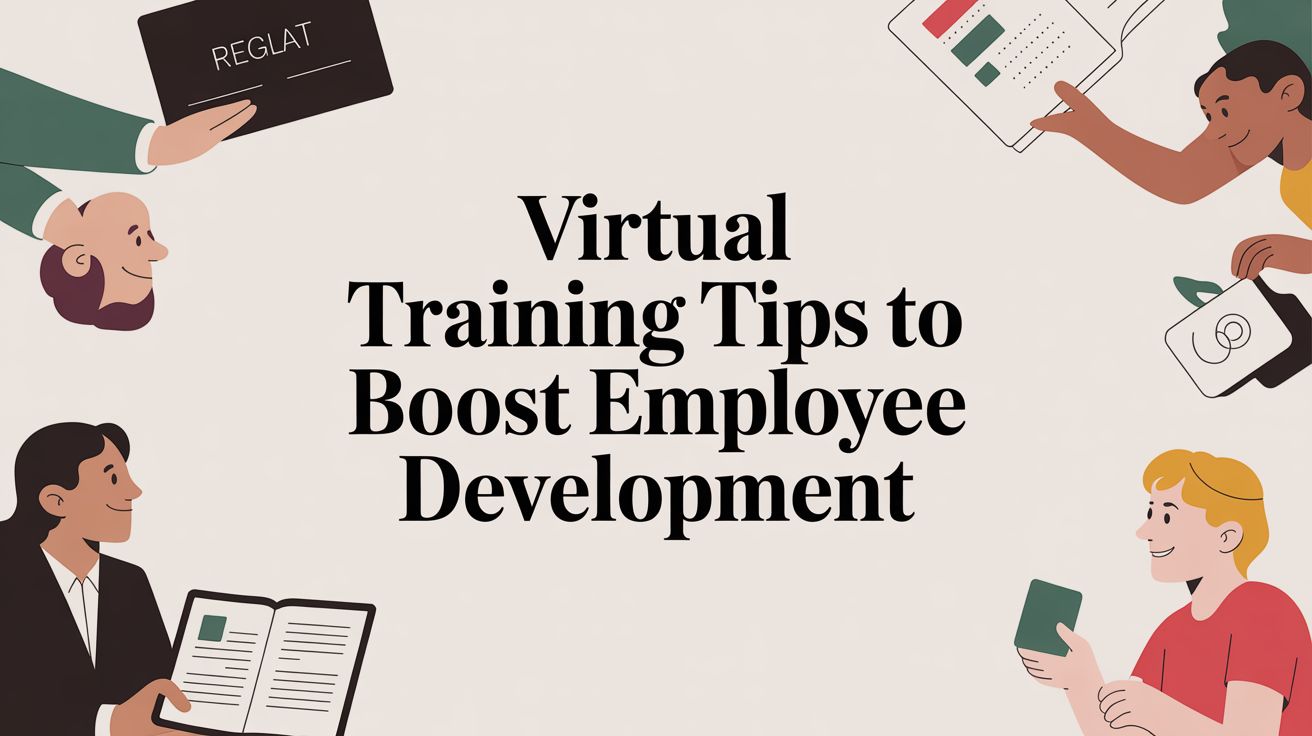Mastering Learning and Development Courses
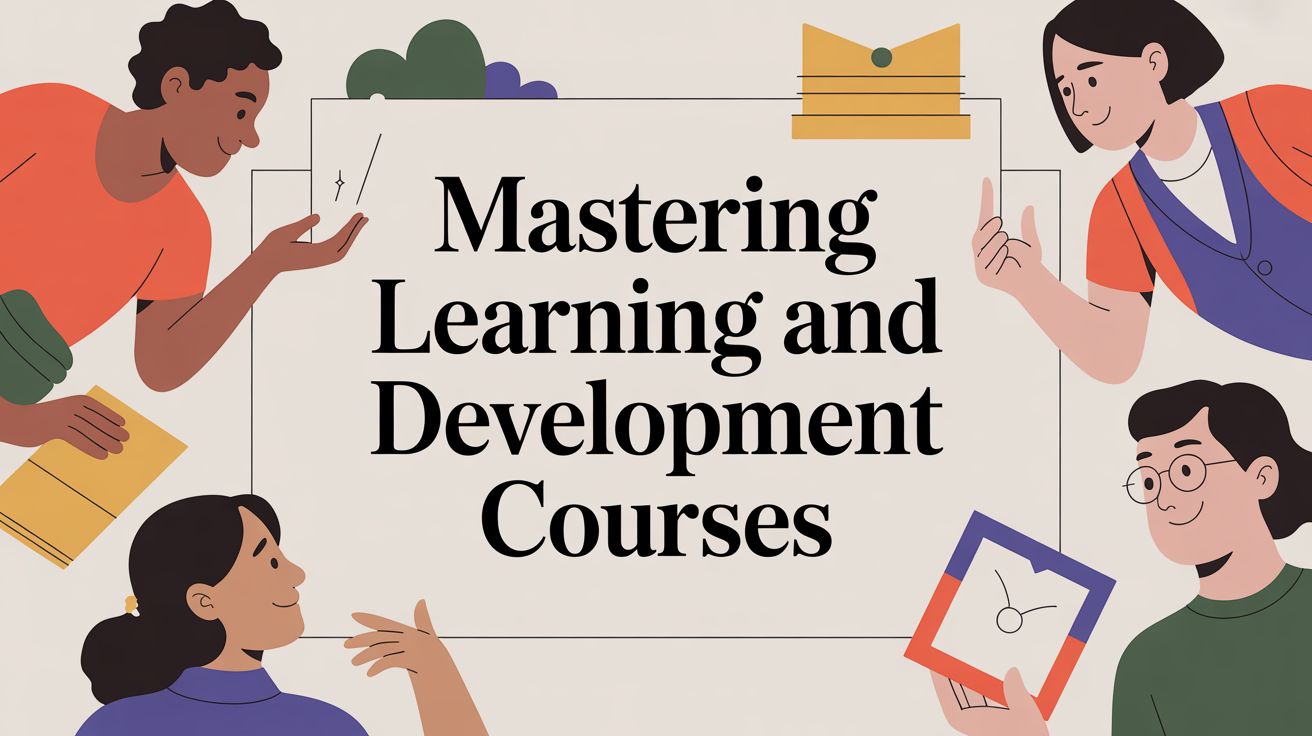
Learning and development courses are far more than just a nice-to-have corporate perk. Think of them as a direct investment in your organization's future, designed to build skills, boost performance, and drive real growth. These programs are the engine that cultivates a resilient, adaptable, and genuinely engaged workforce.
Why L&D Courses Are a Strategic Investment
In today's fast-moving business world, a solid L&D program isn't just helpful—it’s a powerful tool for creating a sustainable competitive advantage. It’s about moving beyond simply plugging immediate skill gaps and instead focusing on building long-term organizational capability. This is the crucial difference between basic training and true strategic development.
Here’s a simple way to look at it: training is like giving someone a fish. It solves an immediate need, like getting them up to speed on a new software tool. Development, on the other hand, is like teaching them how to fish. It gives them foundational skills they can apply to all sorts of challenges throughout their career, like mastering project management or becoming a better leader.
Fostering Growth and Retaining Talent
The smartest companies know that investing in employee growth is one of the surest ways to boost engagement and keep people from walking out the door. When your team sees a clear path for advancement and feels the company is genuinely invested in their success, their motivation and commitment skyrocket.
This isn't just about warm feelings; it has a direct impact on the bottom line. Organizations that make L&D a priority often see significant improvements across the board:
- Productivity: Well-equipped employees simply work more efficiently and make fewer mistakes.
- Innovation: A culture of continuous learning naturally encourages fresh ideas and creative problem-solving.
- Employee Retention: People are far less likely to jump ship when they see opportunities to grow right where they are.
One of the most powerful outcomes of L&D is its ability to help employees understand how to improve critical thinking skills, which leads directly to better decision-making and innovation.
Key Insight: A modern talent strategy isn't just about hiring the right people; it's about continuously developing the people you already have. Effective L&D programs transform your workforce into a dynamic asset that adapts and excels.
Adapting to a Changing Market
The pace of change is relentless. New technologies and shifting market demands mean the skills we need today might be obsolete tomorrow. It's no surprise that the global corporate training market is exploding, with projections showing it will reach over $500 billion by 2030, according to a report by Grand View Research. This isn't just a fad; it's a fundamental shift in how we work and learn.
By offering targeted learning and development courses, companies can make sure their teams have the right skills to navigate whatever comes next. This proactive approach, often managed through a dedicated training management system, builds a resilient workforce that’s ready for the future. You can learn more about building a highly skilled team in our guide on implementing competency-based training.
Picking the Right Kind of L&D Course
Think of choosing a learning and development course like picking the right tool for a job. You wouldn't use a sledgehammer to hang a picture frame, right? In the same way, the format of your training has to match exactly what you're trying to teach. The first step in building a program that actually works is understanding the main types of L&D courses out there.
The world of professional training is vast, with different courses built to solve specific problems within a company. When you match the content and delivery style to your goals, you create a learning experience that sticks and leads to real, measurable improvements.
The Main Buckets of L&D Courses
Most corporate training programs can be sorted into a few core categories, each serving a unique purpose. Knowing what they are helps you focus your efforts and spend your budget wisely.
- Leadership Development: These programs are all about growing the skills your current and future leaders need. They typically cover big-picture topics like strategic thinking, clear communication, making tough decisions, and keeping teams motivated.
- Technical Upskilling: This is where you'll find training for specific, job-related "hard skills." Think learning a new software platform, getting the hang of a programming language, or becoming certified to operate a piece of equipment.
- Soft Skills Workshops: These are the people skills—the abilities that are valuable no matter what your job title is. We're talking about courses on communication, teamwork, creative problem-solving, and emotional intelligence.
- Mandatory Compliance Training: This is the essential stuff that keeps everyone safe and the company out of trouble. It covers required topics like workplace safety, data privacy rules, and anti-harassment policies.
Leadership development, in particular, is a massive focus for companies. The market for these programs is expected to jump from $89.54 billion in 2025 to a staggering $238.5 billion by 2035, according to a report from Future Market Insights. Even with all the new tech, in-person workshops are still the most popular way to deliver this training.
How Should You Deliver the Training?
Once you've figured out what to teach, you have to decide how you're going to deliver it. Every format has its pros and cons, making each one a better fit for different situations. If you want to go deeper, we've put together a complete guide on the various delivery methods used in training.
The delivery method you choose has a huge impact on learner engagement, how many people you can reach, and of course, the cost. For tricky, hands-on skills where people need to interact and get feedback on the spot, you can't beat live instruction. But if you need to get foundational knowledge out to a huge, spread-out team, self-paced online courses are way more practical.
Pro Tip: Don't get stuck using just one delivery method for everything. The smartest L&D strategies mix and match, picking the format that makes the most sense for what each specific course is trying to achieve.
To help you sort through the options, let's compare the most common formats for L&D courses.
Comparison of Training Course Delivery Formats
This table breaks down the main ways to deliver L&D courses, highlighting their characteristics, where they shine, and what challenges to watch out for.
| Format | Key Characteristics | Best For | Challenges |
|---|---|---|---|
| Instructor-Led Training (ILT) | Face-to-face learning in a classroom with a live instructor. It’s highly interactive and great for collaboration. | Complex skills, hands-on practice, team-building activities, and teaching nuanced soft skills. | Higher cost per person, logistical headaches (booking rooms, travel), and it's hard to scale. |
| Virtual Instructor-Led (VILT) | Live training delivered online through platforms like Zoom or Microsoft Teams. Everyone is online at the same time. | Interactive sessions for remote teams, expert-led Q&As, and situations needing real-time feedback without the travel. | "Zoom fatigue" is real, technical glitches can derail a session, and it’s tough to replicate truly hands-on activities. |
| Asynchronous eLearning | Self-paced online modules that people can access whenever and wherever they want, usually through a Learning Management System (LMS). | Foundational knowledge, compliance training, software tutorials, and delivering consistent information to lots of people. | Can have lower engagement, no immediate instructor feedback, and learners can feel isolated. |
| Blended Learning | A hybrid model that mixes live instruction (either in-person or virtual) with self-paced online work. | Creating a complete learning journey, reinforcing ideas with online practice, and offering maximum flexibility. | Requires smart design to make the different parts feel connected and can be complex to manage. |
In the end, choosing the right L&D course and its delivery method is a strategic move. By thinking carefully about your goals, your audience, and your resources, you can build a training program that isn't just efficient—it's one that truly makes a difference.
Designing Courses That Actually Drive Change
A great L&D course isn't just a polished presentation. It's a carefully engineered experience designed to create a real, measurable change in how someone does their job. The difference between a training session that's forgotten by lunchtime and one that actually sticks comes down to smart design.
This process, which we call instructional design, is both an art and a science. It's about building learning that genuinely works.
To avoid reinventing the wheel, instructional designers often lean on proven frameworks. One of the most trusted and straightforward models out there is ADDIE. It breaks the entire creative process down into five clear, manageable phases.
- Analysis: First, who are you teaching? What do they already know, and what's the specific gap you need to fill for them to perform better?
- Design: Next, you map it out. What are the concrete learning objectives? How will you structure the content and what's the best way to deliver it?
- Development: This is where the rubber meets the road. You build the actual materials—slide decks, workbooks, videos, and interactive exercises.
- Implementation: Time to go live. The course is delivered to learners, whether that’s in a classroom, online, or a mix of both.
- Evaluation: Finally, did it work? This crucial last step is all about measuring impact and figuring out how to make the next course even better.
Starting with Clear Objectives
Before you even think about creating a single slide, you have to define what success looks like. This means crafting clear, measurable learning objectives. A vague goal like "improve communication skills" is a recipe for failure because you can't measure it.
Instead, a strong objective is specific and action-oriented. For example: "By the end of this workshop, participants will be able to use the STAR method to answer behavioral interview questions." See the difference? This gives you a clear target to aim for and a simple way to know if you hit it.
Actionable Advice: Always frame your learning objectives from the participant's point of view. Start your sentences with, "After this session, you will be able to..." This simple trick forces you to focus on the tangible skills your learners will walk away with.
Creating Content That Engages
With your objectives locked in, the next hurdle is creating content that actually grabs—and holds—people's attention. The secret is to make the material relevant and interactive. People learn best when they can immediately see how it applies to their day-to-day work. Research from the Association for Talent Development (ATD) shows that applied, hands-on learning significantly boosts retention rates.
To stop your L&D courses from feeling like a lecture, try mixing in these elements:
- Realistic Job Scenarios: Pull examples and case studies straight from the challenges your employees are facing right now.
- Interactive Elements: Get people doing, not just listening. Build in group discussions, role-playing, and problem-solving challenges.
- Varied Media: Break things up! Use a combination of short videos, infographics, and hands-on activities to appeal to everyone.
A huge part of making learning stick is providing great reference materials. Knowing how to create training manuals that engage and teach is a skill in itself, ensuring the key lessons aren't forgotten once the session ends.
Tailoring the Experience to Your Audience
Ultimately, the most effective training is never one-size-fits-all. To truly drive change, you have to know your audience and tailor the material directly to them. Think about their existing knowledge, their specific job roles, and even how comfortable they are with different types of technology.
A course built for brand-new hires should look and feel completely different from a workshop for senior leadership. By understanding who your learners are and what they really need, you can design an experience that resonates on a personal level and delivers results that last.
Getting Your L&D Program Off to a Great Start
You can have the most brilliant learning and development course in the world, but if the launch fizzles out, so will the results. A great rollout is so much more than just sending a calendar invite. It’s about building momentum, showing people the value, and making sure all the behind-the-scenes details are buttoned up. The real goal here is to shift training from a “have-to” task into a “want-to” opportunity.
That shift starts with clear, compelling communication. You have to get people genuinely excited and bought into the idea from day one. When your team understands why a course is happening and how it actually helps them with their own career goals, they’re going to show up ready to learn.
Building Buzz and Getting Buy-In
Think of your communication plan as an internal marketing campaign. It’s all about creating awareness and answering that all-important question for every single employee: "What's in it for me?" To make sure your message hits home, it's usually best to use a few different channels.
Here are a few tactics that really work:
- Get Leaders Involved: When a respected leader champions a training program, it instantly gives it weight and importance. A quick video message or a personal email from them can make a huge difference.
- Announce It Where People Are: Don't just rely on one mass email that gets lost in the inbox. Talk about it in team meetings, feature it in your internal newsletter, and post about it on company chat channels.
- Focus on the Value: Instead of just listing topics, spell out the benefits. Talk about the specific skills people will walk away with and how those skills can help them do their job better or even move up in the company.
When you frame your L&D courses as a direct investment in your people's future, you start building a culture that truly values growth.
Picking the Right Tech for the Job
Behind every smooth-running L&D program, there’s a set of tools making it all happen. The right technology handles the nitty-gritty of scheduling, resources, and communication, which lets you focus on what matters most—the training itself. But you have to choose the right tool for the job.
Asynchronous e-learning is widespread. One report showed that by 2023, 98% of corporations were planning to use some form of online learning. And the market for Learning Management Systems (LMS) is expected to reach $28.1 billion by 2025. You can dig into more of these stats and the research behind them over at Continu.com.
This data points to a really important difference in training technology. While an LMS is great for hosting self-paced online courses, it’s not built for the logistics of live training.
Key Distinction: A Learning Management System (LMS) is a platform for delivering and tracking asynchronous e-learning content. A Training Management System (TMS) is a platform for managing the logistics and operations of live, instructor-led training events (face-to-face, virtual, or hybrid).
If your organization relies on any kind of instructor-led training (ILT)—whether that’s in-person, virtual, or a mix of both—then a Training Management System is what you need. A TMS like Coursebricks is specifically designed as an operational back-end to handle the complex logistics that an LMS was not made for.
Here’s a simple way to think about it: an LMS is like the digital library where all your self-study materials live. A TMS, on the other hand, is the event planner for your live classes and workshops. It handles everything from schedules and instructor assignments to room bookings, registrations, and sending out automated reminders. It’s the engine that ensures your live learning and development courses run without a hitch.
Measuring the True Impact of Your Training
Launching a new learning and development program feels like a big accomplishment. But once the courses are live, the real work begins. The most important question you can ask is: is any of this actually working?
To prove the value of your training and secure future budgets, you have to look beyond simple attendance sheets. It's about demonstrating a real return on investment (ROI) by connecting the dots between learning and business performance. When you can show that training directly impacts company goals, L&D stops being seen as a cost center and becomes what it truly is—a strategic engine for growth.
A Framework for Measuring What Matters: The Kirkpatrick Model
So, where do you start? One of the most trusted and effective frameworks for this is the Kirkpatrick Model. Think of it as a four-step guide that takes you from gut feelings to hard data, helping you measure everything from initial reactions to tangible business results.
This model gives you a clear roadmap. By working through each level, you build a complete picture of your program’s effectiveness, making it easy to spot what’s working and what needs to be tweaked.
Here’s how the four levels break down:
- Level 1: Reaction – How did people feel about the training? This is all about immediate feedback, usually gathered with a quick survey right after the session ends.
- Level 2: Learning – Did they actually learn anything? This is where you measure knowledge gain with quizzes, tests, or hands-on skill assessments.
- Level 3: Behavior – Are they using what they learned back on the job? This requires a bit more detective work, like manager observations or performance reviews.
- Level 4: Results – Did the training impact the business? This is the ultimate goal—connecting new behaviors to key business metrics and calculating the true ROI.
Practical Ways to Collect Meaningful Data
Gathering data for each of those levels requires a mix of different methods. The trick is to choose tools that give you real insights, not just numbers to fill a spreadsheet. When training really hits the mark, a whopping 91% of learners report a deeper understanding of the subject, which is a fantastic starting point.
Here are a few ways you can gather the right data for each level:
- For Reaction: Keep it simple. Use anonymous feedback forms or quick polls immediately after a course. Ask about the instructor, the relevance of the content, and if the materials were helpful.
- For Learning: Measure the knowledge gap. A pre-course assessment followed by a post-course assessment is a classic for a reason. For a sales course, you could try a role-playing exercise; for a technical one, a practical skills test works great.
- For Behavior: Check in a few weeks or a month after the training wraps up. Talk to both the employee and their manager. Things like 360-degree feedback or direct observation can reveal if new skills are sticking.
- For Results: This is where you tie it all back to the bottom line. Track key performance indicators (KPIs) that matter to the business. Did customer support tickets drop after a service workshop? Did sales conversions climb after a negotiation course?
Key Takeaway: The goal is to tell a complete story with your data. A positive reaction is nice, but showing a direct link between a training course and a 21% boost in profitability, as some studies on training ROI have found, is what truly demonstrates the power of your L&D program.
Ultimately, measuring your training isn't just about proving its value—it's about improving it. The data you collect creates a powerful feedback loop that helps you refine course content, adjust how you deliver it, and ensure your learning and development courses are always driving your organization's most important goals.
Want to dig deeper into this? Check out our complete guide on how to measure training effectiveness.
Getting a Handle on Your Instructor-Led Training
While self-paced eLearning is great for scale, many of the most powerful learning and development courses still happen live. There's just no substitute for instructor-led training (ILT)—and its virtual cousin, VILT—when it comes to teaching complex skills, sparking real collaboration, and building a strong team culture.
But let's be honest. Anyone who's ever run these programs knows the behind-the-scenes work can be a complete logistical nightmare.
The administrative weight is staggering. You're juggling instructor schedules, booking rooms (or virtual breakout rooms), manually tracking who's signed up, and sending what feels like a million follow-up emails. This isn't just time-consuming; every manual step is a chance for a costly mistake that can sour the whole learning experience.
The Headaches of Managing ILT by Hand
Trying to manage live training with a patchwork of spreadsheets and disconnected calendar apps simply doesn't work once you start to grow. The entire process gets bogged down by the same frustrating problems over and over, draining your team's energy and creating a clunky experience for learners.
Sound familiar? These are the usual suspects:
- Scheduling Conflicts: Accidentally double-booking your star instructor or reserving a conference room that someone else already claimed.
- Registration Chaos: The endless grind of typing in attendee details, trying to manage waitlists, and processing payments one by one.
- Communication Breakdowns: Realizing you forgot to send out crucial pre-course reading materials or the post-session feedback survey.
- Resource Juggling: Having no clear, central view of which instructors, rooms, or pieces of equipment are actually available.
When your team is buried in these operational details, they can't focus on what really matters: designing and delivering incredible training that actually improves performance. This is precisely when a specialized tool goes from "nice-to-have" to absolutely essential.
Enter the Training Management System
To get out of this administrative quicksand, savvy organizations use a Training Management System (TMS). It's crucial to understand that a TMS is not the same as an LMS. While a content-focused LMS is built for self-paced eLearning, a TMS is the command center for all the logistics of live and hybrid training.
Think of it as the air traffic control tower for your entire ILT program. A TMS like Coursebricks brings all the moving parts into one central hub, making sure every session runs like a well-oiled machine from start to finish.
The Key Difference: An LMS is a digital library for your asynchronous eLearning content. A TMS is the event management platform for your live, instructor-led training sessions.
How a TMS Puts Training Logistics on Autopilot
A solid TMS takes over all those repetitive, soul-crushing tasks, which frees up your L&D team to get back to creating meaningful learning experiences. For a closer look at what goes into a successful live session, you can explore the core components of effective instructor-led training programs.
Here’s a snapshot of how a system like Coursebricks makes life easier:
- A Central Course Catalog: It creates a single source of truth where everyone can see all available courses, schedules, and instructor details.
- Smart Scheduling & Resource Management: The system automatically manages calendars for instructors, rooms, and equipment, preventing conflicts before they happen.
- Seamless Registration: Attendees can browse, register, and even pay for courses through a simple online portal, with all their information captured instantly.
- Automated Communications: It handles everything from sending booking confirmations and pre-course reminders to distributing certificates and feedback forms afterward.
By automating these core administrative functions, a TMS helps you deliver a polished, professional, and seamless experience for everyone involved. Ultimately, it makes your live learning and development courses far more effective and much easier to scale.
Common Questions About L&D Courses (And Straightforward Answers)
To wrap things up, let's tackle a few of the most common questions that pop up when you're in the trenches building and managing L&D programs.
How Much Should We Really Budget for L&D?
Figuring out the right L&D budget can feel like trying to hit a moving target. A good starting point, and a widely used benchmark, is to set aside anywhere from 1% to 3% of your total employee payroll.
But that's just a benchmark. The final number really depends on your specific situation. For instance, in-person training with instructors, venues, and travel costs will always be more expensive than a virtual workshop. The complexity of the material and who you're training—new hires versus senior leaders—also plays a big part. It never hurts to see what similar companies in your industry are spending to make sure your investment is in the right ballpark.
What’s the Real Difference Between a TMS and an LMS?
This is a huge one, and getting it right can save you a lot of headaches. While the acronyms are similar, a Learning Management System (LMS) and a Training Management System (TMS) are built for completely different jobs.
An LMS is all about content delivery. Think of it as a digital library. Its main purpose is to host and track self-paced eLearning courses that employees can take whenever they want.
On the other hand, a TMS, like Coursebricks, is all about operations. It’s the command center for managing the logistics of instructor-led training, whether it's happening in-person, online, or as a hybrid event. It’s built to handle the messy, real-world details like scheduling, booking rooms, managing registrations, and keeping everyone in the loop.
The Bottom Line: If your training program is built around live instructors and scheduled events, you need a TMS. If you’re mostly pushing out self-paced online modules, an LMS is your tool. Many companies actually end up using both to cover all their bases.
How Do We Get People to Actually Take Voluntary Courses?
Just announcing a new course and hoping for the best rarely works. If you want people to sign up for voluntary training, you have to build a culture where learning feels like a genuine opportunity, not just another item on their to-do list.
Here are a few strategies that get real results:
- Connect it to their careers. Show employees a clear line from a training course to a promotion or a new role. When people see how it directly benefits their career path, their motivation skyrockets.
- Get leaders on board. When senior leaders openly support the training program—and even participate themselves—it shows everyone that it’s a priority.
- Provide real incentives. This doesn't always have to be cash. Think about offering professional certifications, digital badges for their LinkedIn profile, extra time off, or even a bonus for finishing a challenging learning track.
- Market your courses internally. Don't just send one email. Share testimonials from past attendees. Highlight the practical, on-the-job skills people will walk away with. Treat it like a real marketing campaign.
Ready to explore Coursebricks?
Manage training programs, automate emails, and generate detailed reports — all in one place.




